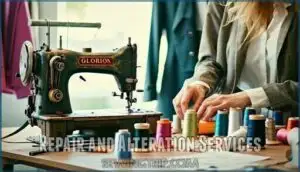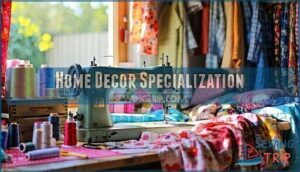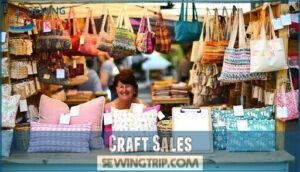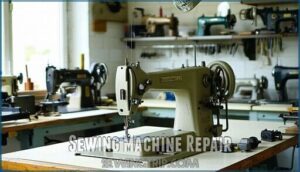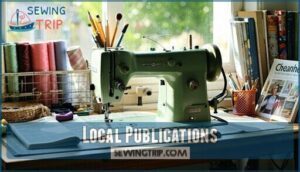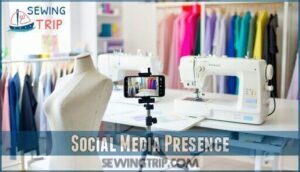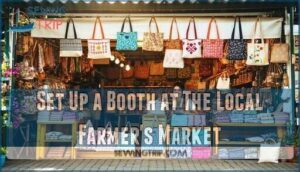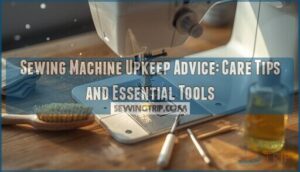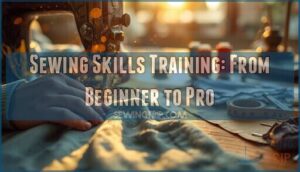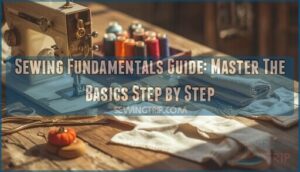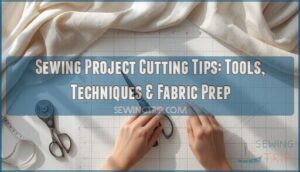This site is supported by our readers. We may earn a commission, at no cost to you, if you purchase through links.
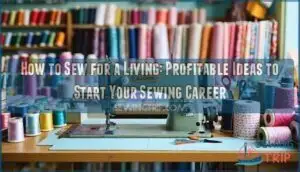 Turning your sewing skills into a living isn’t as hard as threading a stubborn needle. Start with services like alterations or custom garment making—folks always need pants hemmed or unique outfits crafted.
Turning your sewing skills into a living isn’t as hard as threading a stubborn needle. Start with services like alterations or custom garment making—folks always need pants hemmed or unique outfits crafted.
Offer home decor too, like curtains or throw pillows, if that’s your jam. Build an online presence through Instagram or Etsy to show off your work and attract clients.
Don’t forget to price smartly—factor in materials, time, and skill. You could even teach sewing or repair machines for extra income.
The key is blending creativity with business savvy. Who knew stitches could lead to financial freedom? Keep reading for more ideas!
Table Of Contents
Key Takeaways
- Focus on simple services like alterations, custom garments, or home decor to quickly monetize your sewing skills.
- Use social media platforms like Instagram or TikTok to showcase your work, attract clients, and build a following.
- Price your services smartly, factoring in materials, time, and expertise to ensure fair compensation.
- Explore additional income streams like teaching sewing lessons, selling handmade crafts, or repairing sewing machines.
Ways to Make Money With Sewing
You can turn your sewing skills into a steady income by offering services like alterations or creating handmade crafts.
With a bit of creativity and smart planning, your passion for sewing can become a thriving business.
Repair and Alteration Services
Offering sewing alterations and repairs is a practical way to earn steady income.
Sewing alterations and repairs turn simple skills into a steady income while boosting clients’ confidence in their favorite garments.
Fix broken zippers, repair clothes, or perfect couture repairs like wedding gowns.
Master textile knowledge, tailoring techniques, and complex alterations to meet every client’s needs.
Pricing strategies guarantee fair costs while covering your skills and time.
Researching current alteration costs helps guarantee competitive rates.
Communicate clearly with clients to build trust, and remember—every button you replace or hem you alter boosts someone’s confidence!
Garment Making
Garment making is a fantastic way to grow your sewing income while flexing your creativity.
Garment making lets you unleash creativity, crafting stunning, unique outfits while transforming your sewing passion into profit.
Whether you’re crafting handmade clothing or diving into couture techniques, custom garments allow you to showcase your skills.
Start with pattern drafting—it’s the backbone of great garmentmaking.
Pair that with thoughtful fabric selection to achieve the perfect blend of style and function.
Pay attention to seam finishes and fit adjustments; these details elevate your work from ordinary to exceptional.
Want to stand out? Try your hand at designing wedding dresses, Halloween costumes, or other custom pieces.
Fashion design gives you endless opportunities to create unique items people love.
To get started, explore a variety of garment making patterns.
With practice and passion, garment making can transform your sewing business into a profitable venture rooted in fabric and artistry.
Home Decor Specialization
Transform your sewing passion into a home-based business by specializing in home decor!
With skills like fabric selection and cushion design, you can create one-of-a-kind pieces that customers will love.
Explore projects like custom curtains, duvet covers, or stylish pillowcase styles.
By mastering pattern drafting, you’ll confidently bring any idea to life.
Home decor sewing is highly profitable, as everyone loves adding a personal touch to their space.
You can find many home decor sewing products to help get started.
Whether you’re sewing for profit online or selling at local markets, this niche offers endless opportunities to earn a sewing income while turning houses into cozy, inviting homes.
Start today and turn your passion into a successful sewing income!
Sewing Tutor
If you love teaching techniques and seeing people light up with new skills, becoming a sewing tutor could be your calling.
Offer personalized lessons that focus on student projects like hemming, pattern drafting, or neckline alterations.
Tailor your classes to your students’ goals, whether they’re beginners or advanced learners, and share tips on lesson planning, skill development, and even choosing materials.
Charge between $35 and $55 an hour, or offer package deals, and you’ll also teach and inspire others while building your sewing career.
Craft Sales
Teaching others to sew is fulfilling, but nothing beats selling handmade items you’ve poured your heart into.
Craft sales are a smart way to turn your sewing skills into income. Start by researching trends and picking projects that excite buyers, like tote bags or pillowcases.
Craft fair tips include organizing an eye-catching display booth or keeping detailed inventory management. Don’t overlook pricing handmade goods—factor time, materials, and profit.
Create an Etsy shop for year-round exposure or connect locally. Customer engagement is key, so chat with buyers—it often leads to loyal fans who’ll spread the word about your sewing business!
Sewing Machine Repair
If you’re great with your hands and enjoy solving puzzles, sewing machine repair might be your calling.
After all, every sewer knows the frustration of a jammed bobbin or skipped stitch. Repairing sewing machines means tackling common issues like thread tension, broken needles, or pesky motor problems.
You’ll want solid repair tools, a good understanding of machine types, and knowledge of parts sourcing. Start by studying maintenance tips, watching tutorials, or even pursuing sewing machine repair certification.
Don’t overlook vintage sewing machines—they’re treasures deserving special care. You can cater to hobbyists or small sewing businesses, keeping their machines humming smoothly while earning from a skill that’s always in demand.
Advertising and Marketing Techniques
You’ve mastered sewing, but knowing how to advertise your skills is just as important.
From word of mouth to online marketplaces, smart marketing can turn your passion into a thriving business.
Word of Mouth
Word of mouth is your secret weapon for growing your sewing business.
Start by engaging in community events or sewing networking groups. Build trust with sewing clients through local partnerships and active community engagement—people naturally share great experiences.
Consider creating referral programs to reward loyal customers. Use customer testimonials to showcase your work—they’re more convincing than any ad!
Attend networking events to meet potential sewing clients and partners. Don’t underestimate casual chats; a simple conversation can lead to valuable opportunities.
Stay active in the local scene, and soon enough, buzzing word of mouth will do most of your sewing marketing!
Flyers
In regards to promoting your sewing business, flyers can be your secret weapon.
With a well-thought-out flyer design, you can grab attention and showcase your services effectively.
Make sure your message is clear and focused with a strong call to action.
Here’s how to make your flyers work:
- Highlight your services: Focus on what makes your sewing business unique (alterations, lessons, custom garments).
- Choose distribution spots wisely: Think flea markets, craft fairs, or libraries.
- Appeal to your target audience: Use friendly, relatable language and visuals.
- Track success: Add a coupon or contact form to measure impact.
Flyers, combined with a solid distribution strategy, can sew success into your marketing efforts!
Consignment Shops
Consignment shops are fantastic for showcasing your sewing skills and boosting your homebased business.
Partner with shop owners to offer tailoring tips or unique garments crafted using expert pattern drafting techniques.
Use creative display techniques, like mannequins or styled bulletin boards, to present your pieces and stand out.
Focus on pricing strategy and inventory management, ensuring fair profits.
By negotiating contracts clearly, you’ll secure a win-win partnership, and sewing for income can thrive when local shops highlight your craft effectively.
Online Marketplaces
After exploring consignment shops, let’s look at online marketplaces. You can really boost your sewing business by using the power of online marketplaces! With product reviews, easy price comparisons, and customer service, it’s easy to see why sewers are sewing online.
Platforms like Etsy and Faire let you create a shop with ease, so people can view and buy your unique items.
- Etsy Optimization
- Product Photography
- Shipping Logistics
- Marketplace Fees
Setting up shop involves marketing strategies, like email campaigns. Good customer service is key. Don’t wait any longer; take control of how you earn money with sewing today through the power of online sales.
Business Cards
Want your sewing business to leave a lasting impression? Business cards can do just that! Think of them as your mini portfolio—pocket-sized but packed with personality.
Start with a standout card design that matches your brand. Use quality paper and vibrant printing options to reflect the quality of your work.
Make sure your information hierarchy is clear—include your name, contact info, and specialties, like alterations or custom garments. Don’t forget your sewing jobs website or social media handles!
Have a solid distribution strategy too. Hand them out at craft fairs, place them in local shops, or include them with every customer order. Track ROI by noting where new clients heard about you. These little cards can stitch your business success story!
Local Publications
Tap into the power of local publications to boost your sewing business.
Magazine advertising, newspaper ads, community newsletters, and local directories are fantastic ways to put your name on the map.
Print media might seem old-school, but it connects you directly with people who want personalized sewing jobs.
For example, imagine someone flipping through a community newsletter, spotting your ad for custom prom dresses or custom baby outfits—it’s an instant connection!
Ads in local publications reach customers who value quality and want to shop local, whether it’s freelance sewing projects or larger custom orders.
Start small with a classified in a local newspaper or a simple ad in a neighborhood magazine.
Highlight your skills in sewing as a career, focusing on customizations and professionalism.
Consistent visibility builds trust and keeps you top-of-mind the next time someone needs sewing services nearby.
Social Media Presence
Building a strong social media presence lets you showcase your sewing skills and connect with potential clients.
Platforms like TikTok, Instagram, and YouTube make it easy to share your work, attract followers, and grow your business.
TikTok
TikTok is a goldmine for growing your sewing business and connecting with a creative audience.
Share bite-sized examples of your work through short-form sewing content like tutorials, quick tips, or before-and-after projects.
Try hopping on Sewing TikTok Trends or creating Viral Sewing Challenges to keep things fresh and fun.
Engage viewers with these ideas:
- Post TikTok Sewing Tutorials on basic stitches or fabric hacks.
- Show off final products to highlight your sewing business model.
- Share sewing fails or behind-the-scenes clips for authenticity.
The TikTok algorithm thrives on genuine, engaging content, so don’t be afraid to show personality—add fun music and trending hashtags to boost reach.
TikTok can skyrocket your sewing online presence with just one viral post!
Instagram’s perfect for building your sewing community and growing your sewing business.
Post eye-catching images that showcase your skills—whether it’s a vibrant dress or a clever upcycle.
Use visual storytelling to connect with followers and inspire creativity.
Hashtag research is key; target relevant hashtags to reach local makers and potential clients.
| Content Idea | Purpose | Examples of Posts |
|---|---|---|
| Before-and-After Pics | Highlight transformations | Outfit alterations, upcycles |
| Sewing Tutorials | Educate your audience | Short reels on techniques |
| Finished Products | Attract buyers | Custom dresses, crafts |
YouTube Channel
A YouTube channel can boost your sewing business and connect with a wider audience.
Share sewing tutorials, promote your sewing blog, and attract customers keen to learn or shop.
Use channel monetization to turn views into revenue.
Here’s how to succeed:
- Invest in basic video equipment for quality content.
- Stick to a content calendar for consistent uploads.
- Engage viewers with sewing for beginners projects.
- Use editing software to polish videos.
- Respond to comments to build audience engagement.
Set Up a Booth at The Local Farmer’s Market
Setting up a booth at the local farmer’s market is a fantastic way to showcase your sewing business.
Start by obtaining market permits and checking local guidelines. Plan an eye-catching booth display—use balance, symmetry, and a splash of color to draw customers. Select inventory thoughtfully, offering items like tote bags, handmade aprons, or unique home decor staples.
Use clear price signs for easy market pricing, and offer payment methods like cash or mobile apps. Customers love personal touches, so arrange your space to reflect your brand. Also, bring essentials like water, paper bags, and sanitizer for seamless local sales.
| Essential Tips | Why It Matters | Quick Tip |
|---|---|---|
| Symmetrical displays | Draws attention | Use risers for height balance |
| Clear pricing signs | Builds trust | Use bold, legible fonts |
| Multiple payment methods | Encourages purchases | Offer apps like Venmo |
| Thoughtful inventory | Appeals to buyers | Focus on unique sewing items |
| Friendly demeanor | Attracts customers | Greet everyone warmly |
Build a Blog and Specialize
A blog can turn your sewing passion into a thriving business.
After showcasing your skills at a farmer’s market or community event, focus on building an online space where your creativity shines.
Start by finding your niche—whether it’s sustainable fashion, kids’ clothing, or home decor.
Specialization helps you stand out in the crowded sewing world.
Plan your content strategy around tutorials, project showcases, and tips for sewing success.
Learn basic SEO optimization to help your audience find you online.
Use social media to funnel readers to your blog, but don’t stop there—explore blog monetization through ads, affiliate partnerships, or digital pattern sales.
Community building is key.
Engage readers through newsletters or comment sections and share your journey.
Blogging isn’t just about sewing—it’s about creating relationships that foster trust and lead to sewing online sales!
Frequently Asked Questions (FAQs)
Can I make a living from sewing?
Yes, you can make a living sewing!
Offer services like alterations, custom garments, or pattern designing.
Sell online, teach classes, or repair machines.
Mix creativity with smart marketing, and watch your passion pay off!
Can I make a career out of sewing?
Turning a hobby into a career feels like threading a needle—tricky but doable.
With skills, creativity, and persistence, sewing can pay the bills, whether through custom designs, alterations, or teaching others your craft.
What is the most profitable thing to sew?
The most profitable thing to sew depends on demand and your skills, but custom clothing, bridal wear, or home decor items like curtains and cushions often sell well.
Unique designs and quality work can boost earnings.
What is it called when you sew for a living?
You’re not just a stitcher; you’re an entrepreneur in fashion or crafts.
When you sew for a living, it’s called being a seamstress, tailor, dressmaker, or textile artist, depending on your niche.
What type of equipment do I need to start a sewing business?
To start a sewing business, you’ll need a reliable sewing machine, quality scissors, measuring tools, fabric, thread, pins, and a table.
Add a mannequin and iron for extra polish on your creations!
What are the licensing requirements to operate a sewing business?
Did you know 44% of small businesses skip proper licensing?
Don’t be that person!
Check local regulations for permits, business licensing, zoning rules, and tax IDs.
It’s easier than repairing a mismatched zipper later, and proper licensing is crucial for avoiding issues.
What are the best fabrics and materials to use when sewing?
Choose cotton for versatility, linen for breathability, and silk for elegance.
Avoid slippery fabrics at first—stick with forgiving materials like cotton blends.
Bonus tip: pre-wash fabrics to prevent surprises after your masterpiece is finished!
How can I find customers for my sewing business?
Finding customers can feel like unraveling a mystery, but it’s simple: share your work on social media.
Connect at local markets, offer referral incentives.
Partner with nearby boutiques or consignment shops.
What are the tax implications of running a sewing business?
When running a sewing business, you’ll manage taxes like self-employment tax, income tax, and possible sales tax.
Track expenses like fabric and tools for deductions, and consider consulting a tax professional to avoid headaches.
How can I estimate fabric quantities effectively?
Think of fabric like a canvas; measure project dimensions, add seam allowances, and account for shrinkage.
For clothes, use pattern guides.
Don’t skimp—a little extra fabric can save you from last-minute oops moments!
Conclusion
Did you know the global sewing market is worth billions?
That’s proof your skills can lead to more than just hobbies. Whether you’re offering alterations, designing custom garments, or teaching others, there are countless ways to make sewing for a living profitable.
Focus on showcasing your talent, pricing fairly, and marketing smartly—especially online. With creativity and persistence, you’ll stitch together a thriving career.
Why wait? Start turning your passion for sewing into a paycheck today!

